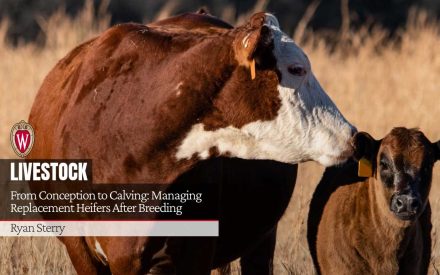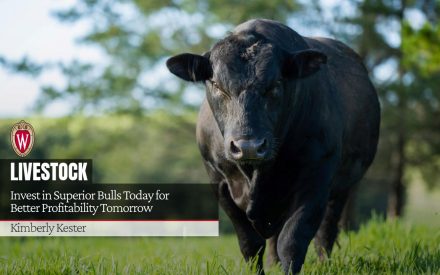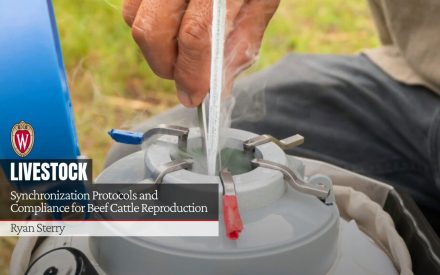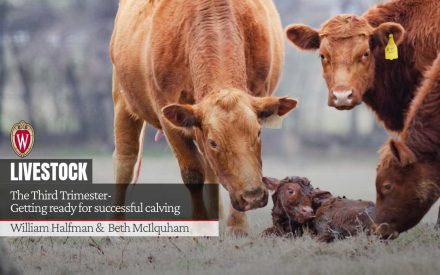Beef cow-calf producers are feeling the pinch of low pasture and hay yields due to drought conditions across the state. Corn silage is another feed source that can be used to help meet the herd’s nutritional needs.

Test for toxins before feeding
The drought has negatively impacted many corn fields that may be candidates to chop for cattle feed. Increased risk of high nitrates and mycotoxins in these fields means caution needs to be taken. Nitrate accumulates in the lower portion of the stressed corn plant and is converted into nitrite in the rumen, or if the fresh chopped corn is allowed to heat in a pile. Nitrite then affects the oxygen-transporting capability of the animal, causing asphyxiation (suffocation). Corn stressed during ear development and pollination is also susceptible to mold and mycotoxin development. Mycotoxins can cause reduced feed intake, diarrhea, abortions and weight loss. Both nitrate and mycotoxin levels can be tested for so appropriate action can be taken to keep risk to a minimum. The cost of the tests is minimal compared to the lost value of potential dead cattle and production loss, especially with the current high cattle prices.
Drought stress impact on yield
Drought stress tends to impact yield more than quality. UW Corn Agronomist Joe Lauer evaluated yield and quality data from the UW Corn Silage Trials to determine how drought stress impacted yield and quality of corn silage.
In years where the drought stress was only prior to pollination, forage yield tended to be lower compared to normal years and grain yield was not affected. Corn plants were shorter but had a greater proportion of grain in the silage, resulting in lower neutral detergent fiber content and greater starch content.
In years where the drought stress extended into pollination and grain fill, forage yields were 18 -46% lower. Quality, measured by using the Milk Per Ton quality index, was reduced by 3-8%. The silage had a lower starch content due to lower grain content.
Forage quality and drought-stress
Wisconsin research led by Jim Coors evaluated the forage quality of corn with 0, 50 and 100% pollination of the kernels on an ear in Wisconsin in 1992 and 1993. As ear fill increased from 0 to 100%, whole plant crude protein decreased by 1%, neutral detergent fiber decreased by 8%, acid detergent fiber decreased by 4%, and in vitro true digestibility increased by 3%. These years were not drought-stress years, however, the treatments mimicked drought stress during pollination and ear fill and the results were comparable to what was reported by Lauer.
Following are some management practices to follow when feeding drought-stressed corn silage:
- Check with your crop insurance agent to determine how that may influence coverage and what evidence may need to be preserved for yield determination.
- If cutting earlier than normal, or a field not initially intended to be harvested for silage, follow pre-harvest intervals of pesticides that were applied to the crop.
- Nitrates are highest in the lower part of the plant, raising the chopper height to 8 to 12 inches will reduce the amount of nitrate in the harvested material, this is especially important if feeding it as green chop.
- If feeding green chop, only chop enough that the cattle can get it eaten in about 2 hours, so it does not heat. It may be necessary to feed cattle twice a day to avoid feed heating.
- If it rains enough that plants re-hydrate, delay harvest for at least 3 days after the rainfall event as the rain causes an increase in nitrogen uptake in the plant. After 3 days the nitrogen should be converted to plant protein. Testing for nitrates would be good insurance to know what you have. This is especially important if feeding as green chop.
- Ensiling the crop can reduce nitrates by 40-60% if allowed to go through a 21-28 day fermentation period before feeding.
- Increased nitrate concentration in the plants increases the risk of silo gas. Information on silo gas and safety precautions can be found here: Silo Gas and Silo-Filler’s Disease – Team Forage (wisc.edu)
- Corn silage with high nitrates and or mycotoxins can be diluted with non-affected feed to reduce the total nitrate or mycotoxins levels of the rations to safe levels.
- Options for corn silage storage including upright and horizonal silos, bags, etc. Ideally, removal rate should be considered when sizing the storage structure to minimize risk of spoilage at the feedout face. Recommended removal rates are a minimum of 4-6 inches per day in winter and 6-12 inches per day in summer.
- Take steps to ensile the silage at the correct moisture for good fermentation and feed quality. Drought-stressed and hail-damaged corn are difficult to determine when to begin checking whole plant moisture for harvest timing. Visual appearance can be misleading.
- This year, some fields have big differences in emergence, and it may be necessary to harvest in sections rather than the whole field.
- Corn silage, including most drought-stressed corn silage, will need to be limit fed or included in a ration with lower quality forage to beef cows to prevent over-conditioning. It may require protein supplementation to meet cows’ needs. Work with your nutritionist to make sure cows’ needs are being met.
- Make sure there is plenty of bunk space, 30 inches per head, if limit feeding to make sure all cows can get access to the feed. In addition, separating the young, old and more timid cows from the others can be to their benefit.
In summary, drought-stressed corn is an option to meet feed needs for beef cattle. Care should be taken to minimize potential risks and optimize it’s use. Correctly harvesting and storing corn silage combined with balancing rations based on feed tests and good bunk management will help efficiently use limited feed resources and get the most value for the money.
Resources
Lauer, J. Agronomy Advice: Drought Stress Reduces Corn Silage Yield More Than Quality. Field Crops 28.493-48, August 2007.Skjolass, C. A., Muck, R., Holmes, B. Silo Gas and Silo-Filler’s Disease Safety Notes. Silo Gas and Silo-Filler’s Disease – Team Forage (wisc.edu). accessed 08-11-2023.
Coors, J. G., K. A. Albrecht and E. J. Bures. Ear-Fill Effects on Yield and Quality of Silage Corn. Crop Science, 37:243-247.

 From Conception to Calving: Managing Replacement Heifers After Breeding
From Conception to Calving: Managing Replacement Heifers After Breeding Invest in Superior Bulls Today for Better Profitability Tomorrow
Invest in Superior Bulls Today for Better Profitability Tomorrow Synchronization Protocols and Compliance for Beef Cattle Reproduction
Synchronization Protocols and Compliance for Beef Cattle Reproduction The Third Trimester- Getting ready for successful calving
The Third Trimester- Getting ready for successful calving


